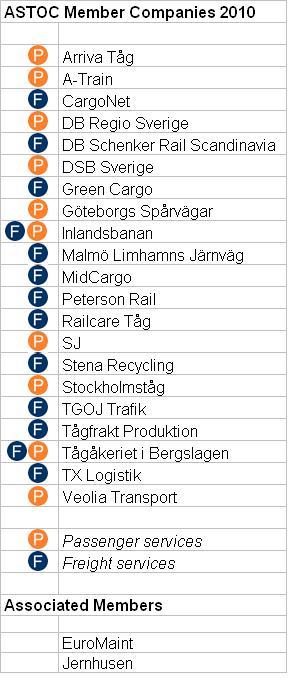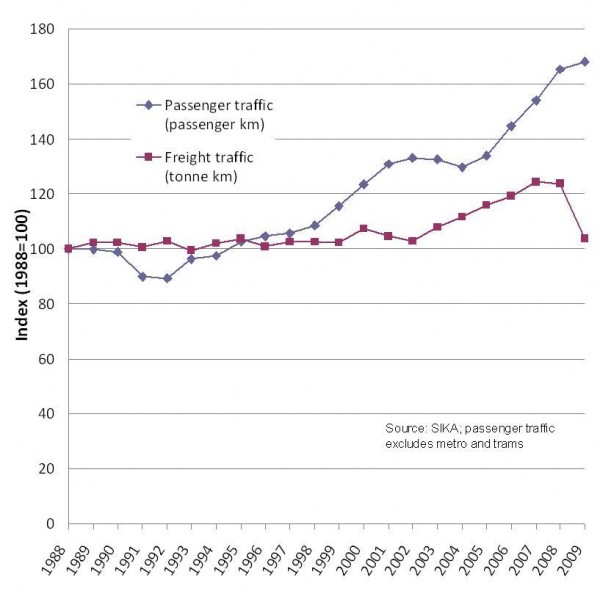ASTOC continues to help shape Sweden’s future transport policy
Posted: 17 September 2010 | | No comments yet
The Association of Swedish Train Operating Companies (ASTOC) acts on behalf of Sweden’s train operators. It seeks to represent the interests of commercial rail traffic in its dealing with the Government and Parliament, authorities, business principals, the media and other bodies. ASTOC also assists in increasing the rail industry’s know-how and competitiveness by providing information, advice and services to members. During 2009-2010, a number of topics have attracted the interest and work of ASTOC, not least related to the latest developments of Swedish transport policy.
The Association of Swedish Train Operating Companies (ASTOC) acts on behalf of Sweden’s train operators. It seeks to represent the interests of commercial rail traffic in its dealing with the Government and Parliament, authorities, business principals, the media and other bodies. ASTOC also assists in increasing the rail industry’s know-how and competitiveness by providing information, advice and services to members. During 2009-2010, a number of topics have attracted the interest and work of ASTOC, not least related to the latest developments of Swedish transport policy.
The Association of Swedish Train Operating Companies (ASTOC) acts on behalf of Sweden’s train operators. It seeks to represent the interests of commercial rail traffic in its dealing with the Government and Parliament, authorities, business principals, the media and other bodies. ASTOC also assists in increasing the rail industry’s know-how and competitiveness by providing information, advice and services to members. During 2009-2010, a number of topics have attracted the interest and work of ASTOC, not least related to the latest developments of Swedish transport policy.
ASTOC now has 21 members of train operating companies carrying either passengers or freight. Sometimes they are involved in both business areas (see Figure 1). During the past year it has also become possible for other rail-related organisations to join ASTOC as associated members. So far, this has led to the addition of two associated members: Euromaint and Jernhusen. Euromaint is one of the leading firms for vehicle maintenance. Jernhusen is the Swedish state’s real estate company in the railway sector, owning approximately 150 stations all over the country. Jernhusen is also a major holder of facilities for maintenance purposes.
As a consequence of the financial crisis and the ongoing recession, the year 2009 meant that freight traffic in Sweden was severely hit (down 17% compared to 2008) while passenger services managed to stand stable (see Figure 2 on page 00). During 2010, the situation for freight has so far improved. First quarter statistics show that freight volumes (in tonne km) increased by 19% compared to the first quarter of 2009, and the major freight operator Green Cargo was able to show a profit for the second quarter of 2010.
Following a long process of planning and discussions (involving ASTOC, the transport authorities and a number of other stakeholders), the government, in March 2010, finally decided on a new plan for the transport system (road and rail), covering the period 2010-2021. It means that SEK 417 billion will be set aside for the rail and road sector. The government is also expecting funds to come from other sources, including co-funding of projects by e.g. municipalities, adding another SEK 65 billion. From ASTOC’s point-of-view, the plan is unfortunately not as focussed on rail as it should be and a number of important projects for the improvement of capacity and a continued positive development of rail transport in Sweden are either not included or only appear towards the latter part of the period. Moreover, despite earlier commitments and official statements, Sweden will not yet go ahead with the construction of a dedicated high-speed rail network (300km/h or over) from Stockholm to Gothenburg/Malmoe. This means that capacity constraints will continue to be severe on several parts of the network that carry many different kinds of rail traffic. One of the major advantages of a dedicated high-speed rail network would be to separate the fastest running passenger trains from regional services and freight services.
In April 2010, the planned merger between the National Road Administration (Vägverket) and the National Rail Administration (Banverket) was completed (following a political decision in 2009). The new authority, the Swedish Transport Administration (Trafikverket) now has the joint responsibility for the further development of both sectors, also including some elements of authorities related to other transport modes. It remains to be seen how this will affect the Swedish railway sector in the long run, but so far the cooperation between ASTOC and Trafikverket has more or less continued where Banverket left off.


Figure 1 ASTOC members
The past year has been one in which the weather has played a major role for both daily train operations and transport policy in general. The winter 2009-2010 was, if not extreme by Swedish standards, unusual in many respects. It struck in mid-December with snow and temperatures dropped to well below zero. It then stayed rather cold for several months (including the southern parts of Sweden) without any interruption, and the snow just continued to come. In January and February this brought the railway sector into something of a crisis. One of the primary problems was to keep the tracks free from snow, another was the frozen switches. Both passenger services and freight services were severely affected. In mid-February, Sweden’s main marshalling yard in Hallsberg even had to close down completely for almost two weeks because of all the snow. Naturally, this had direct implications for the train operating companies and their customers, but it also alerted the government to take action. A number of follow-up investigations are currently being completed in order to identify the problems and find ways of handling them well before the next winter. ASTOC is actively taking part in this work.
Later in spring, the transport sector was affected by the ash fall-out from the Eyjafjallajökull volcano, but in this case mostly in a positive sense for the railway sector. Several train operators were able to put in extra resources and run more trains in order to handle additional demand for rail transport while the airlines were grounded. The government also temporarily lifted some restrictions to facilitate this work.
The new deregulated environment for domestic passenger rail services (with open access) is about to be accomplished. Formally, the market will be open from October 2010, but given the long process of timetabling, we may not see the full impact until early 2012. ASTOC is still worried that current and future capacity constraints will hamper the development of a truly competitive market. Moreover, there is no new official model yet for the distribution of slots when there are conflicting demands for capacity.


Figure 2 Development of passenger and freight traffic in Sweden 1988-2009
In parallel to the work of deregulating the domestic passenger rail services, the government in 2009 also launched an initiative to look into a new framework and legislation for public transport in general. One idea was that more competition could help revitalise the development of this market. In spring 2009, a government committee suggested a far-reaching deregulation of all public transport services and a new interface between tendered and commercial services, favouring the latter. In the end, the government settled for more modest changes in the final version of its proposal for a new legislation for public transport, adopted by Parliament in June 2010. There will be a general market-opening for local and regional public transport (primarily affecting bus services but also rail) but new commercial services will not take precedence to subsidised, tendered services (as originally suggested by the committee in 2009). In practice, they will therefore primarily complement already available public transport services at some margin. From ASTOC’s pointof- view, a disturbing feature of the new legislation is that new commercial services will have very limited protection against the possible expansion of the subsidised services procured by traffic authorities.
One of the hottest topics in Swedish transport policy right now, where ASTOC has a major role to contribute to the debate, is the evolution of track access charges and other fees affecting train operations. A more differentiated charging structure is on its way, which, if done correctly, could make the use of the track infrastructure more efficient. However, the government has also decided to impose a major increase in the level of charges. In principle, the charges will be doubled within a period of four years. In addition, fees related to the introduction of ERTMS will add even more to the bill. Sweden has traditionally kept rail charges low in order to stimulate entry and growth of rail transport, with the objective to keep it a competitive alternative to other modes of transport. In ASTOC’s view, the new policy direction of increasing charges will affect the competitiveness of the sector in a negative way, with potentially severe implications for the rail freight business and its customers.
ASTOC also continues to play an active role in the development of European Union transport policy, primarily through its membership in the Community of European Railways and Infrastructure Companies (CER). During the latter half of 2009, Sweden held the presidency of the Council of the European Union. As a part of an initiative related to the presidency, ASTOC cooperated with CER and the Swedish Ministry of Enterprise, Energy and Communications in the organisation of a seminar event in Brussels called ‘From Brussels with Law’. It focused on different ways to improve the conditions for rail transport in Europe. For example, it was shown how the stakeholders of the sector themselves can sometimes take on the task to create the appropriate institutional environment for market actors, diminishing the need for detailed EU legislation on each and every aspect.
In September 2010, Sweden will have a new general election to Parliament. A shift in majority in favour of the currently opposing Social Democrat, left and green parties may have an impact upon current initiatives on investment levels, charging and marketopening. In any case, ASTOC will continue to take part in the shaping of Sweden’s future transport policy.
About the Author
Gunnar Alexandersson
Gunnar Alexandersson (M.Sc.) is a Senior Policy Adviser at the Association of Swedish Train Operating Companies (ASTOC). He also works part-time as a Researcher at Stockholm School of Economics (where he has been since 1996), specialising in studies on regulatory reforms in the transport industry and the impact of the introduction of competitive tendering of bus and railway services. His PhD dissertation is expected in September 2010. For a period in 2007-2008, he worked as Senior Economics Policy Adviser at the Community of European Railways and Infrastructure Companies (CER) in Brussels.
OUT NOW: The Definitive Guide to Rail’s Digital Future
The rail industry is undergoing a digital revolution, and you need to be ready. We have released our latest market report, “Track Insight: Digitalisation.”
This is not just another report; it’s your comprehensive guide to understanding and leveraging the profound technological shifts reshaping our industry. We move beyond the buzzwords to show you the tangible realities of AI, IoT, and advanced data analytics in rail.
Discover how to:
- Optimise operations and maintenance with real-time insights.
- Enhance passenger services through seamless, high-speed connectivity.
- Leverage technologies like LEO satellites to improve safety and efficiency.
Featuring expert analysis from leaders at Nomad Digital, Lucchini RS, Bentley Systems and more, this is a must-read for any rail professional.
Issue
Related organisations
The Association of Swedish Train Operating Companies (ASTOC)



